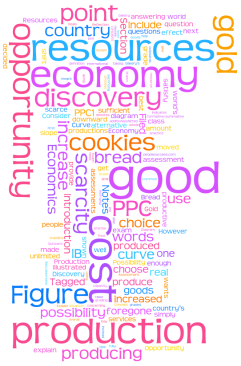4.3 Role of Domestic Factors Data Response (2)
Posted on: February 10, 2012
“Banks Making Big Profits From Tiny Loans”
Question 1: Explain how a microcredit system works.
Microcredit schemes are schemes that lend small amounts to the poor in a developing country. Many economists contend that these loans are a great way to promote growth and development, as they are directly targeted at the people who need them the most, and help to promote an entrepreneurial culture from the ‘bottom-up’.
Question 2: Examine the benefits of using microcredit systems in developing countries to promote economic development.
- Can bring entrepreneurship — The loan granted to poor but talented people can be crucial in lifting their living standards. Poor people have tremendous skills and, in fact, most of them are already self-employed. Microcredit schemes are simply providing additional work and capital so they can grow their small village store, expand trading business, and more.
- Availability — Microcredit system can be a vital role in improving financial access particularly in rural areas that are undersupply of banks.
- Self-esteem and bargaining power in women— Microfinance raises self-esteem and increases bargaining power in women, for women are allowed to get loans. (BUT men redeem control over women and force women away from MFIs.)
- Investment — Microfinance enables people to invest, which may enable people to come out of poverty (BUT finance alone doesn’t help. They need innovation, support, skills, and training as well.)
Question 3: Examine the problems associated with operating microcredit systems and whether these could contribute to a worsening in the levels of poverty.
- High interest rate (as high as 28% or higher, some say over 100% in some cases) — To ensure their economic performance is untarnished, MFIs charge high interest rate to compensate this risk. They are also borrowing money from commercial banks, which means that they need to pay back bank loans as well as pay for operating cost.
- The poor’s inability to offer marketable collateral for loan — Microfinance clients are either very small businesses or poor individuals who usually have few assets, non-existent credit histories, and low-income levels. These clients most likely cannot offer any collateral to microfinance providers against loans. As a result, MFIs may either raise their interest rates or turn down hundreds of applications.
- Vulnerability to economic shocks — Micro entrepreneurs are particularly susceptible to sudden changes in customer demand, or the weather because their businesses cannot sustain losses owning to their small size (i.e. low capital).
- The poor’s lack of education — Micro entrepreneurs have limited skills, qualifications and exposure to handling businesses. Hence, they may borrow more money than needed and/or misallocate it in their business. Thus, they end up bearing the burden of large interest payments instead of succeeding.
- Competition among themselves — All micro entrepreneurs compete with one another in entry-level. Since they are too small in scale, they are unlikely to achieve efficiency. Thus, they would make meager earnings.
- Unstable income — Most microfinianced people will take jobs at factories over their self-employed jobs because they are more stable and steady in terms of income.
Considering the positive and negative effects, microcredit system is not very effective in the short-term since the self-employed individuals are vulnerable because of its small size. The micro entrepreneurs are not only strong enough to sustain losses in an economic shock but also cannot be successful as they use most of their profit to repay their loans. Some micro entrepreneurs cannot even make profit due to high competition and unstable income that they take more loans to repay the first loan, which dramatically increase their debts. Nevertheless, the microcredit system is effective in the long-term, considering that these self-employed individuals do succeed. This is because microfinance allows women to actively participate in the growth of the economy. In other words, more percent of women will be working, which is a positive impact on the growth of an economy. Also, microfinance will encourage innovation in many citizens. This will help the economy to be novel and innovative in the long run, resulting in economic development.

Leave a comment